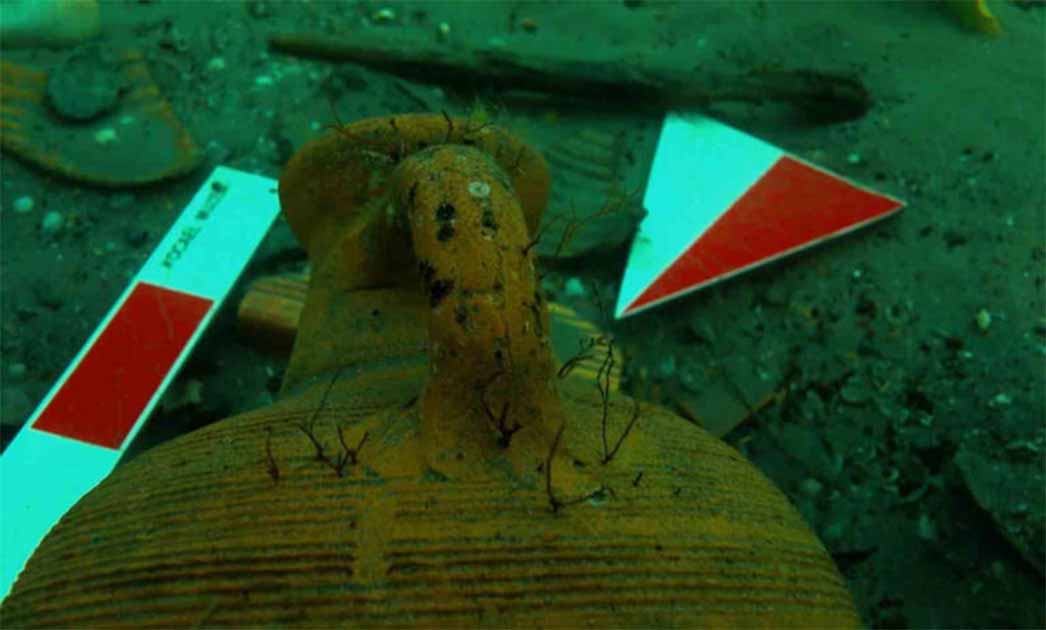First Ever Scientific Underwater Excavation of Black Sea Reveals Ancient Harbor
In 2020, the first ever scientific underwater excavation ever undertaken in the Black Sea was started. Now, the results of that expedition are coming to light, revealing millennia-old artifacts and an ancient harbor town that survived for 1,500 years.

Kerpe is a small bay on the western coast of the Black Sea, around 100km (60 miles) as the crow flies from the great city of Istanbul. The Hellenic word for the bay was “Kalpe” which translates to “pot” or “jug” and hints at the importance of the bay in ancient times.

Finds on the sea bed showcase the harbor’s past as a key waypoint along Black Sea trade routes (IHA / Anatolian Archaeology)
Kerpe was a commercial center through the Roman, Byzantine and Genoese periods, a stopping point and safe harbor for ships travelling along the Black Sea coastline. And now, the finds from this ancient settlement are being revealed in a new exhibition, reports Anatolian Archaeology.
An Ancient Town Beneath the Waves
Kerpe harbor was also a key port in the supply of timber and fuel to Istanbul during the Ottoman period, delivering logs, coal and construction materials to the city. However the harbor had been an important waypoint for long before the time of the Ottomans, before it eventually sunk under the waves.
Artifacts recovered from the sunken settlement have been dated up to 2,400 years old. These include amphorae, the containers popularly used for transport in ancient times, as well as other finds which would be expected from a trading center.

Amphorae on display at the Kocaeli Archaeology Museum (Kocaeli Archaeology Museum / Anatolian Archaeology)
Just as important are the discoveries of the ancient harbor itself. It was the remains of the pier belonging to the Ancient Kerpe harbor which led to the excavation works starting in 2020.
The excavation team dived to the site some 80 meters (260 feet) away from the shore at a depth of 4 meters (13 m). There they worked at recovering scattered finds over an area of approximately 2,000 square meters (21,500 square feet), which included two sections of the ancient pier.
The excavations are ongoing, and are being conducted by the Kocaeli Museum Directorate under the supervision of the Ministry of Culture and Tourism, General Directorate of Cultural Heritage and Museums. Serkan Gedük, Director of Kocaeli Museum which is housing the finds stated:
“We believe that it is extremely valuable in terms of emphasizing the commercial relations between the east and the west from the Antiquity to the Ottoman period in the Black Sea. Therefore, we are trying to exhibit the cultural assets unearthed during the underwater excavations chronologically and with some animations in our museum. During the excavation works, we have identified many underwater cultural heritages, ranging from commercial amphorae remains dating from the 4th century BC to the 12th century AD, to red-glazed ceramics, lamps, pipe fragments, various cultural assets belonging to the Ottoman period and shipwreck remains that we have detected in the region.”
The exhibition is entitled “The Silent Harbor of the Black Sea: Kalpe”. For the first time in millennia, the secrets of Kerpe harbor will be revealed again.
Top Image: An amphora at the bottom of Kerpe’s ancient harbor in the Black Sea. Source: IHA / Anatolian Archaeology.
By Joseph Green
Related Post
A shocking documentary proves that mermaids do exist
SHOCKING Revelation: Thuya, Mother of Queen Tiye, Was the Grandmother of Akhenaten and Tutankhamun—What Ancient Egyptian Secrets Did She Leave Behind?
Breaking News: Astonishing Discoveries at Karahan Tepe Confirm an Extraterrestrial Civilization is Hiding on Earth, and NO ONE Knows!
Breaking News: Researchers FINALLY Discover U.S. Navy Flight 19 After 75 Years Lost in the Bermuda Triangle!
NASA’s Secret Investigation: Uncovering the Astonishing Mystery of the UFO Crash on the Mountain!
Explosive UFO Docs LEAKED: Startling Proof That Aliens Ruled Ancient Egypt!